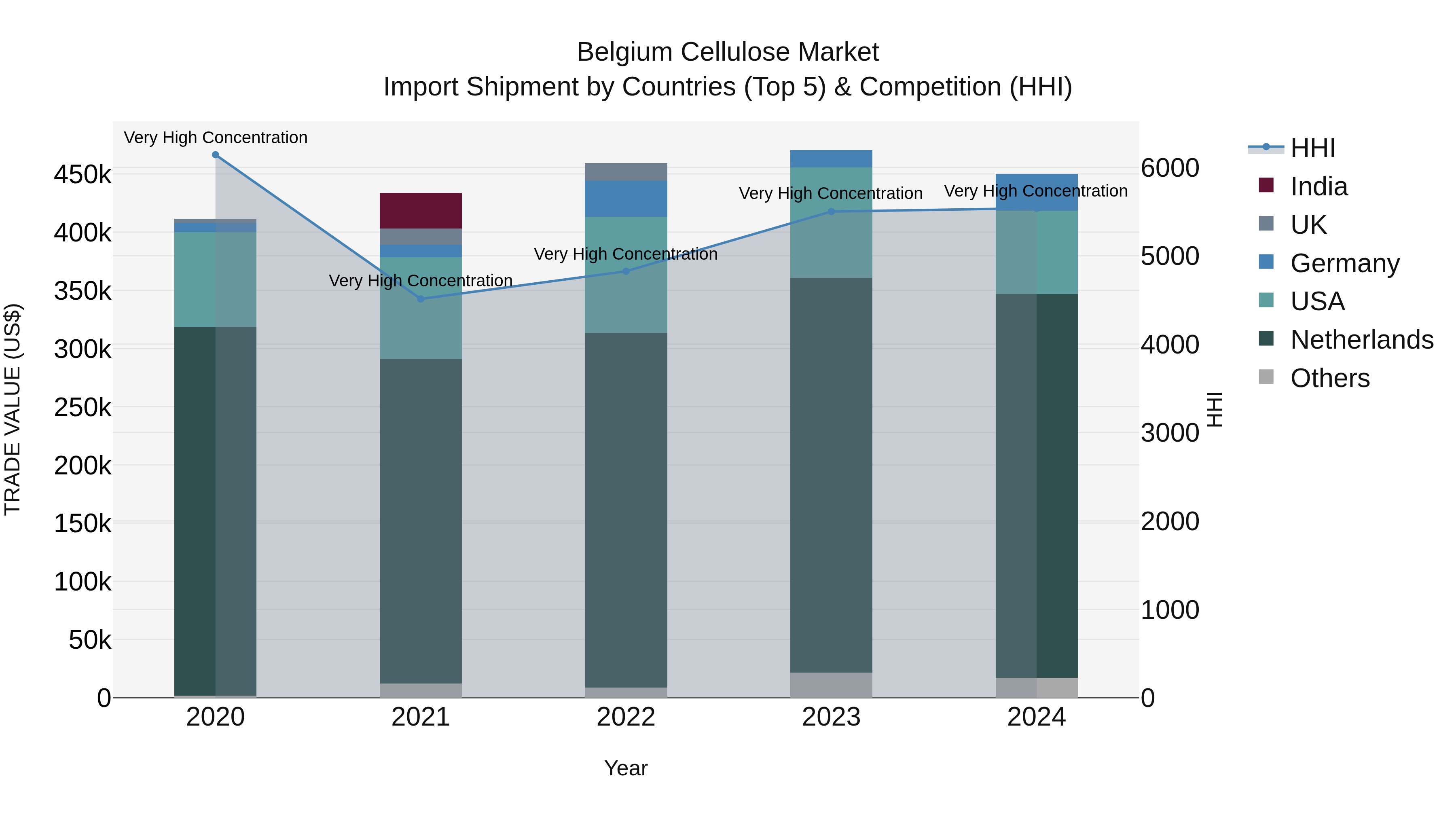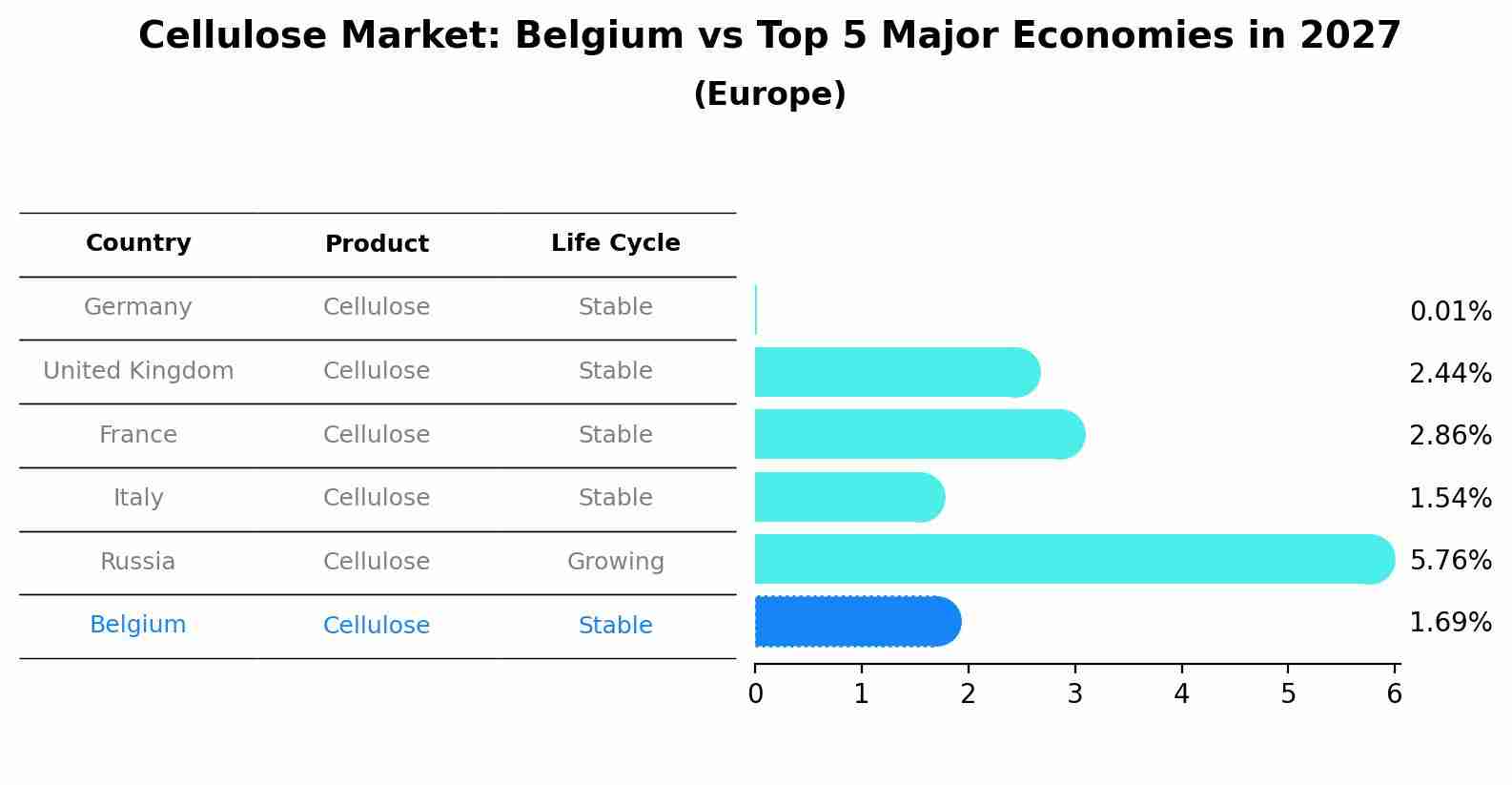Belgium Cellulose Market (2025-2031) | Trends, Share, Industry, Segmentation, Value, Growth, Companies, Forecast, Outlook, Revenue, Size & Analysis
| Product Code: ETC4661919 | Publication Date: Nov 2023 | Updated Date: Oct 2025 | Product Type: Market Research Report | |
| Publisher: 6Wresearch | Author: Shubham Deep | No. of Pages: 60 | No. of Figures: 30 | No. of Tables: 5 |
Belgium Cellulose Market Top 5 Importing Countries and Market Competition (HHI) Analysis
In 2024, Belgium continued to be a key importer of cellulose, with significant shipments coming from top exporting countries such as the Netherlands, USA, Germany, Thailand, and Sweden. Despite a slight decline in growth rate from 2023 to 2024, the compound annual growth rate (CAGR) over the 2020-2024 period remained positive at 2.26%. The high Herfindahl-Hirschman Index (HHI) indicates a concentrated market, highlighting the dominance of these key exporting countries in supplying cellulose to Belgium.

Cellulose Market: Belgium vs Top 5 Major Economies in 2027 (Europe)
In the Europe region, the Cellulose market in Belgium is projected to expand at a stable growth rate of 1.69% by 2027. The largest economy is Germany, followed by United Kingdom, France, Italy and Russia.

Belgium Cellulose Market Overview
The cellulose market in Belgium is characterized by a growing demand driven by its applications in various industries such as paper, textiles, and pharmaceuticals. The market is influenced by advancements in bio-based products and sustainable materials. Government policies promoting the use of renewable resources and environmental sustainability have further bolstered the market growth.
Drivers of the market
The cellulose market in Belgium is primarily driven by the growing demand from the paper and textile industries. Cellulose is a key raw material in the production of paper, and the increasing focus on sustainable and biodegradable materials has boosted its demand. Additionally, the rise in textile production, especially in eco-friendly fabrics, has further propelled market growth. Innovations in cellulose derivatives for applications in pharmaceuticals, food, and cosmetics also contribute to the expanding market. Moreover, supportive government policies promoting the use of renewable resources and increasing investments in research and development are significant drivers for the cellulose market in Belgium.
Challenges of the market
The cellulose market in Belgium faces significant challenges due to fluctuations in raw material prices and the increasing demand for sustainable and eco-friendly products. The high cost of production, driven by energy-intensive processes, poses a barrier to profitability. Moreover, the market is highly competitive, with numerous international players, which exerts pressure on local manufacturers to innovate and maintain cost efficiency. Regulatory hurdles related to environmental standards and the need for continuous investment in R&D to develop biodegradable and recyclable cellulose products further complicate the market dynamics.
Government Policy of the market
Government policies in Belgium affecting the cellulose market primarily focus on sustainability and environmental impact. Regulations encourage the use of biodegradable and renewable materials to reduce carbon footprint and promote recycling initiatives. Tax incentives and grants are provided for companies investing in eco-friendly cellulose production technologies.
Key Highlights of the Report:
- Belgium Cellulose Market Outlook
- Market Size of Belgium Cellulose Market, 2024
- Forecast of Belgium Cellulose Market, 2031
- Historical Data and Forecast of Belgium Cellulose Revenues & Volume for the Period 2021-2031
- Belgium Cellulose Market Trend Evolution
- Belgium Cellulose Market Drivers and Challenges
- Belgium Cellulose Price Trends
- Belgium Cellulose Porter`s Five Forces
- Belgium Cellulose Industry Life Cycle
- Historical Data and Forecast of Belgium Cellulose Market Revenues & Volume By Fiber Type for the Period 2021-2031
- Historical Data and Forecast of Belgium Cellulose Market Revenues & Volume By Natural Cellulose Fibers for the Period 2021-2031
- Historical Data and Forecast of Belgium Cellulose Market Revenues & Volume By Man-made Cellulose Fibers for the Period 2021-2031
- Historical Data and Forecast of Belgium Cellulose Market Revenues & Volume By Applications for the Period 2021-2031
- Historical Data and Forecast of Belgium Cellulose Market Revenues & Volume By Apparel for the Period 2021-2031
- Historical Data and Forecast of Belgium Cellulose Market Revenues & Volume By Home Textile for the Period 2021-2031
- Historical Data and Forecast of Belgium Cellulose Market Revenues & Volume By Industrial for the Period 2021-2031
- Historical Data and Forecast of Belgium Cellulose Market Revenues & Volume By Others for the Period 2021-2031
- Belgium Cellulose Import Export Trade Statistics
- Market Opportunity Assessment By Fiber Type
- Market Opportunity Assessment By Applications
- Belgium Cellulose Top Companies Market Share
- Belgium Cellulose Competitive Benchmarking By Technical and Operational Parameters
- Belgium Cellulose Company Profiles
- Belgium Cellulose Key Strategic Recommendations
Frequently Asked Questions About the Market Study (FAQs):
1 Executive Summary |
2 Introduction |
2.1 Key Highlights of the Report |
2.2 Report Description |
2.3 Market Scope & Segmentation |
2.4 Research Methodology |
2.5 Assumptions |
3 Belgium Cellulose Market Overview |
3.1 Belgium Country Macro Economic Indicators |
3.2 Belgium Cellulose Market Revenues & Volume, 2021 & 2031F |
3.3 Belgium Cellulose Market - Industry Life Cycle |
3.4 Belgium Cellulose Market - Porter's Five Forces |
3.5 Belgium Cellulose Market Revenues & Volume Share, By Fiber Type, 2021 & 2031F |
3.6 Belgium Cellulose Market Revenues & Volume Share, By Applications, 2021 & 2031F |
4 Belgium Cellulose Market Dynamics |
4.1 Impact Analysis |
4.2 Market Drivers |
4.2.1 Increasing demand for sustainable and eco-friendly products |
4.2.2 Growing awareness about the benefits of using cellulose in various industries such as pharmaceuticals, food and beverage, and cosmetics |
4.2.3 Government initiatives promoting the use of cellulose-based products |
4.3 Market Restraints |
4.3.1 Fluctuating prices of raw materials used in cellulose production |
4.3.2 Intense competition from alternative materials in the market |
4.3.3 Regulatory challenges related to environmental impact and sustainability practices |
5 Belgium Cellulose Market Trends |
6 Belgium Cellulose Market Segmentations |
6.1 Belgium Cellulose Market, By Fiber Type |
6.1.1 Overview and Analysis |
6.1.2 Belgium Cellulose Market Revenues & Volume, By Natural Cellulose Fibers, 2021-2031F |
6.1.3 Belgium Cellulose Market Revenues & Volume, By Man-made Cellulose Fibers, 2021-2031F |
6.2 Belgium Cellulose Market, By Applications |
6.2.1 Overview and Analysis |
6.2.2 Belgium Cellulose Market Revenues & Volume, By Apparel, 2021-2031F |
6.2.3 Belgium Cellulose Market Revenues & Volume, By Home Textile, 2021-2031F |
6.2.4 Belgium Cellulose Market Revenues & Volume, By Industrial, 2021-2031F |
6.2.5 Belgium Cellulose Market Revenues & Volume, By Others, 2021-2031F |
7 Belgium Cellulose Market Import-Export Trade Statistics |
7.1 Belgium Cellulose Market Export to Major Countries |
7.2 Belgium Cellulose Market Imports from Major Countries |
8 Belgium Cellulose Market Key Performance Indicators |
8.1 Research and development investment in cellulose technology |
8.2 Number of patents filed for cellulose-based products |
8.3 Percentage of companies in Belgium adopting cellulose in their production processes |
8.4 Sustainability certifications obtained by companies using cellulose |
8.5 Growth in demand for cellulose-based products in key industries in Belgium |
9 Belgium Cellulose Market - Opportunity Assessment |
9.1 Belgium Cellulose Market Opportunity Assessment, By Fiber Type, 2021 & 2031F |
9.2 Belgium Cellulose Market Opportunity Assessment, By Applications, 2021 & 2031F |
10 Belgium Cellulose Market - Competitive Landscape |
10.1 Belgium Cellulose Market Revenue Share, By Companies, 2024 |
10.2 Belgium Cellulose Market Competitive Benchmarking, By Operating and Technical Parameters |
11 Company Profiles |
12 Recommendations | 13 Disclaimer |
- Single User License$ 1,995
- Department License$ 2,400
- Site License$ 3,120
- Global License$ 3,795
Search
Thought Leadership and Analyst Meet
Our Clients
Related Reports
- Germany Breakfast Food Market (2026-2032) | Industry, Share, Growth, Size, Companies, Value, Analysis, Revenue, Trends, Forecast & Outlook
- Australia Briquette Market (2025-2031) | Growth, Size, Revenue, Forecast, Analysis, Trends, Value, Share, Industry & Companies
- Vietnam System Integrator Market (2025-2031) | Size, Companies, Analysis, Industry, Value, Forecast, Growth, Trends, Revenue & Share
- ASEAN and Thailand Brain Health Supplements Market (2025-2031) | Strategy, Consumer Insights, Analysis, Investment Trends, Opportunities, Growth, Size, Share, Industry, Revenue, Segments, Value, Segmentation, Supply, Forecast, Restraints, Outlook, Competition, Drivers, Trends, Demand, Pricing Analysis, Competitive, Strategic Insights, Companies, Challenges
- ASEAN Bearings Market (2025-2031) | Strategy, Consumer Insights, Analysis, Investment Trends, Opportunities, Growth, Size, Share, Industry, Revenue, Segments, Value, Segmentation, Supply, Forecast, Restraints, Outlook, Competition, Drivers, Trends, Demand, Pricing Analysis, Competitive, Strategic Insights, Companies, Challenges
- Europe Flooring Market (2025-2031) | Outlook, Share, Industry, Trends, Forecast, Companies, Revenue, Size, Analysis, Growth & Value
- Saudi Arabia Manlift Market (2025-2031) | Outlook, Size, Growth, Trends, Companies, Industry, Revenue, Value, Share, Forecast & Analysis
- Uganda Excavator, Crane, and Wheel Loaders Market (2025-2031) | Strategy, Consumer Insights, Analysis, Investment Trends, Opportunities, Growth, Size, Share, Industry, Revenue, Segments, Value, Segmentation, Supply, Forecast, Restraints, Outlook, Competition, Drivers, Trends, Demand, Pricing Analysis, Competitive, Strategic Insights, Companies, Challenges
- Rwanda Excavator, Crane, and Wheel Loaders Market (2025-2031) | Strategy, Consumer Insights, Analysis, Investment Trends, Opportunities, Growth, Size, Share, Industry, Revenue, Segments, Value, Segmentation, Supply, Forecast, Restraints, Outlook, Competition, Drivers, Trends, Demand, Pricing Analysis, Competitive, Strategic Insights, Companies, Challenges
- Kenya Excavator, Crane, and Wheel Loaders Market (2025-2031) | Strategy, Consumer Insights, Analysis, Investment Trends, Opportunities, Growth, Size, Share, Industry, Revenue, Segments, Value, Segmentation, Supply, Forecast, Restraints, Outlook, Competition, Drivers, Trends, Demand, Pricing Analysis, Competitive, Strategic Insights, Companies, Challenges
Industry Events and Analyst Meet
Whitepaper
- Middle East & Africa Commercial Security Market Click here to view more.
- Middle East & Africa Fire Safety Systems & Equipment Market Click here to view more.
- GCC Drone Market Click here to view more.
- Middle East Lighting Fixture Market Click here to view more.
- GCC Physical & Perimeter Security Market Click here to view more.
6WResearch In News
- Doha a strategic location for EV manufacturing hub: IPA Qatar
- Demand for luxury TVs surging in the GCC, says Samsung
- Empowering Growth: The Thriving Journey of Bangladesh’s Cable Industry
- Demand for luxury TVs surging in the GCC, says Samsung
- Video call with a traditional healer? Once unthinkable, it’s now common in South Africa
- Intelligent Buildings To Smooth GCC’s Path To Net Zero


















